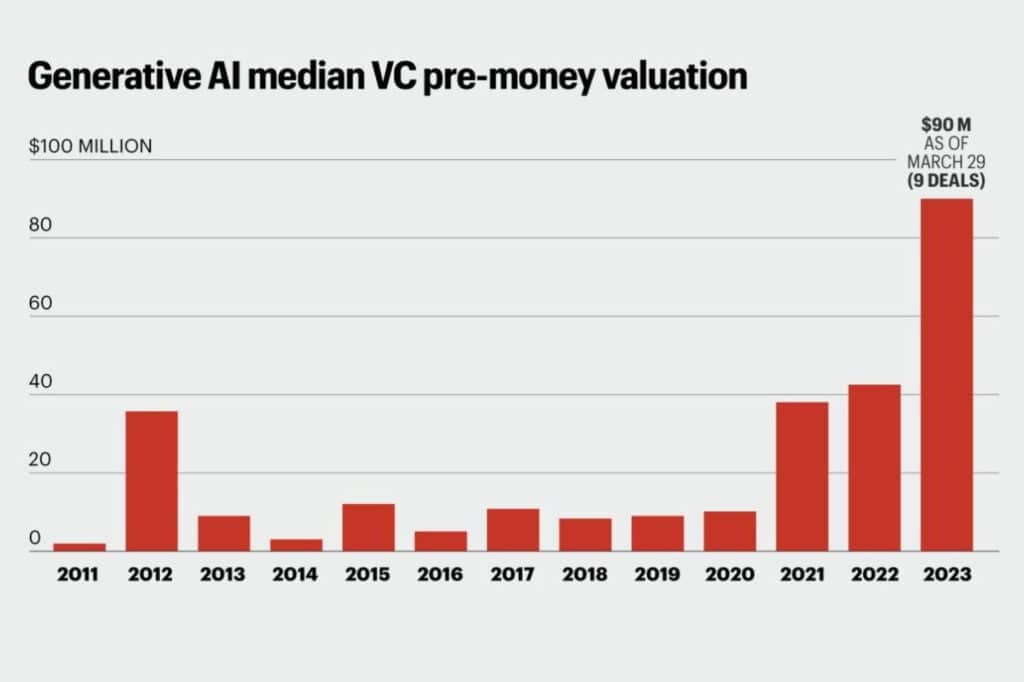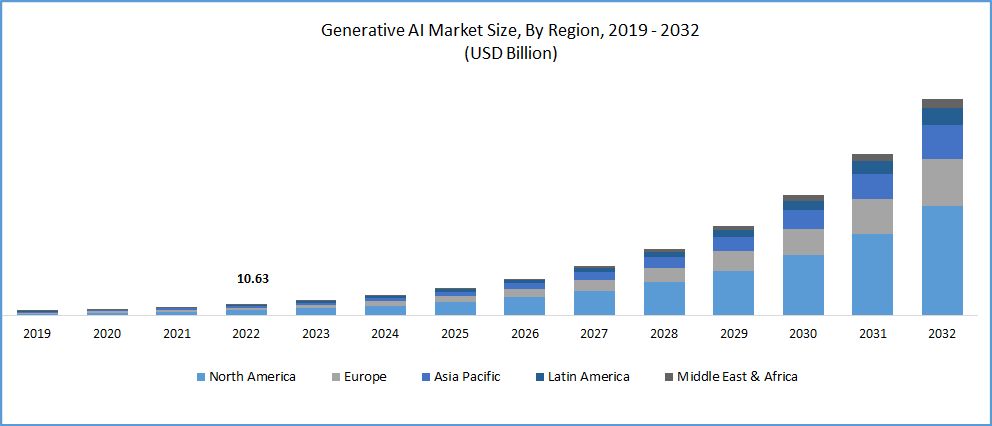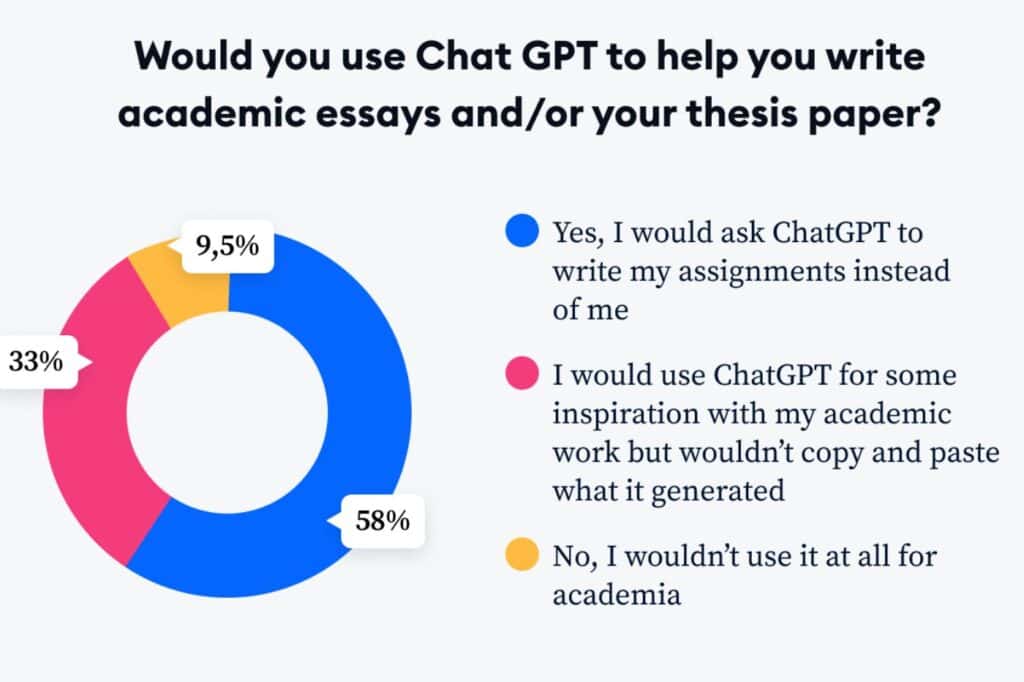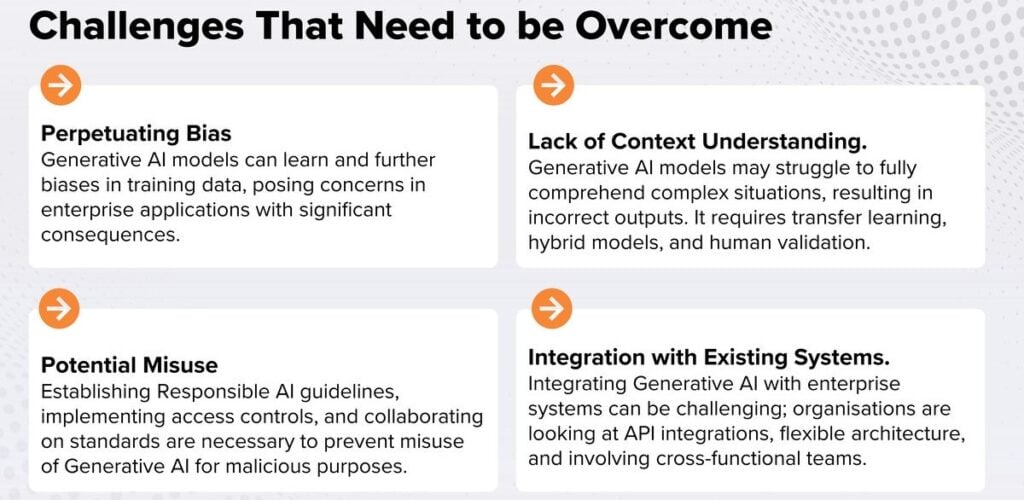From the detailed research conducted by McKinsey to the practical applications of tools like ChatGPT and DALI, it’s evident that Generative AI isn’t just a temporary trend; it’s set to become a stepping stone in technological advancements in the coming decade.
But what does this mean for industries, businesses, and the average consumer? The answer lies in the numbers.

Generative AI statistics provide a comprehensive picture of its growing influence, adoption rates, and potential impact on the global economy.
Whether it’s the creation of realistic virtual worlds, the development of new drug compounds, or the automation of content creation, Generative AI is making its presence felt across diverse sectors.
The world of artificial intelligence has been undergoing rapid transformations, and at the heart of this evolution lies Generative AI. As the name suggests, Generative AI is designed to generate data similar to the data it’s trained on.
This overview delves deep into the most recent and relevant Generative AI statistics, offering insights into its current applications, future potential, and the hurdles that lie ahead.
Through this lens, we aim to provide a holistic understanding of Generative AI’s role in shaping the future of technology and business.
Generative AI Statistics on Adoption Rates Across Industries
The generative AI market size has considerably increased, thanks to its transformative capabilities, and has been making significant inroads across various sectors.

The statistics surrounding its adoption provide a clear picture of how industries are embracing this technology to drive innovation and efficiency.
- Technology and Consulting: These sectors lead the charge in the adoption of Generative AI. According to recent data, the Technology industry has shown an impressive adoption rate of 35%, closely followed by Consulting at 30%. The integration of tools like ChatGPT and DALI has played a pivotal role in streamlining processes and enhancing service offerings in these domains.
- Education and Accounting: The Teaching sector is also catching up, with a 19% adoption rate, leveraging Generative AI for personalized learning experiences and curriculum development. The Accounting industry, known for its meticulous data handling, stands at a 16% adoption rate, utilizing Generative AI for predictive analytics and financial forecasting.
- Healthcare: Despite being one of the most critical sectors, Healthcare lags slightly behind with a 15% adoption rate as of the latest statistics. However, the potential here is immense. From drug discovery to patient care, Generative AI can revolutionize various facets of healthcare.
- Manufacturing: McKinsey’s insights indicate that by 2027, we can expect 30% of manufacturers to integrate Generative AI into their operations. This adoption is driven by the need for precision, efficiency, and the creation of complex designs and prototypes.
- Content Creation and Marketing: With tools like ChatGPT gaining popularity, the content creation realm is witnessing a surge in Generative AI adoption. Marketers and bloggers are leveraging AI to optimize content, with statistics indicating a steady upward trend in its utilization.
Economic and Industry Impact of Generative AI
The statistics and insights from the Generative AI McKinsey Report paint a vivid picture of the profound impact on industries and the broader economy.
- Boost to Global GDP: Current projections suggest that Generative AI could potentially elevate the global GDP by a staggering 7%. This uplift is attributed to increased efficiencies, the creation of new market segments, and the automation of tasks that traditionally required human intervention.
- Revolutionizing Procedural Code Development: By 2025, it’s anticipated that 20% of procedural code will be generated by AI, reducing manual coding efforts and accelerating software deployment cycles.
- Manufacturing Sector: Generative AI is expected to be integrated by 30% of manufacturers by 2027. This adoption will lead to the creation of intricate designs, optimization of production lines, and significant cost savings.

- Pharmaceutical Processes: The drug development process, known for its lengthy timelines and substantial investments, is being expedited by Generative AI. Predictions indicate that by 2025, 50% of new drug compounds could be discovered with the assistance of Generative AI, potentially saving billions and accelerating time-to-market.
- Content Creation: Tools like ChatGPT and DALL-E are reshaping the content landscape. Marketers, designers, and content creators are leveraging Generative AI to produce high-quality content at scale, leading to enhanced user engagement and improved ROI.
- Financial Sector: The intricate world of finance is becoming more predictable with Generative AI. Advanced algorithms are being used for financial forecasting, risk assessment, and fraud detection, ensuring more informed decision-making and safeguarding assets.
Investment and Growth Statistics in Generative AI Market Size
Generative AI, as one of the most promising facets of artificial intelligence, has garnered significant attention from investors and industry leaders alike.
- Market Valuation: As of recent data, the Generative AI market is valued at an impressive $8.65 billion. This figure not only reflects the current adoption rates but also indicates the confidence that industries have in their future applications.
- Projected Market Growth: Looking ahead, the trajectory for Generative AI is steep. By 2030, the market is projected to reach a staggering $15.7 trillion, driven by innovations, broader adoption across sectors, and the development of new AI-driven solutions.
- Private Funding Influx: The United States, as a hub for technological innovation, has seen significant private investments in Generative AI. In 2021 alone, Generative AI initiatives received over $52.9 billion in private funding, underscoring the immense faith investors have in its future returns.

- Regional Market Share: North America, with its advanced tech ecosystem, contributed 42.10% of the global market share for Generative AI in 2022. This dominance is a reflection of the region’s early adoption, robust infrastructure, and continuous investment in research and development.
- Emerging Players: While established tech giants are making significant strides in Generative AI, startups and emerging players are also making their mark. Tools like ChatGPT and DALL-E are prime examples of innovations that have garnered substantial investments and are shaping the future of the Generative AI landscape.
- Sector-specific Growth: Specific sectors, such as content creation, healthcare, and manufacturing, are witnessing exponential growth rates in Generative AI adoption. For instance, the ChatGPT-driven content market is forecasted to see a compound annual growth rate (CAGR) of 18% over the next five years.
Regional Generative AI Adoption Statistics
Generative AI’s global adoption showcases distinct patterns, with each region reflecting its unique technological landscape, investment priorities, and market dynamics.

Here’s a detailed breakdown based on the statistics from the provided content:
North America:
- Contributed 42.10% to the global Generative AI market share in 2022.
- Less than 10% of U.S. residents have utilized Generative AI for social media as of 2023.
- Generative AI initiatives in the U.S. received over $52.9 billion in private funding in 2021.
Europe:
- European countries, particularly the UK and Germany, have seen a 25% increase in Generative AI startup investments since 2020.
- McKinsey reports that European industries, especially automotive and healthcare, are expected to increase Generative AI integration by 20% by 2025.
Asia-Pacific:
- China leads the region with a 30% adoption rate in the manufacturing sector, leveraging Generative AI for design and production optimization.
- Japan and South Korea have reported a 15% increase in Generative AI research grants and projects since 2019.
Latin America:
- Brazil witnessed a 10% growth in Generative AI-driven tech startups in 2022.
- Mexico’s education sector has started piloting Generative AI tools, with an adoption rate of 8% in 2023.
Africa:
- South Africa’s Generative AI market is growing at a CAGR of 12%, with primary focus areas being healthcare and finance.
- Nigeria, as per McKinsey’s insights, is exploring Generative AI for agricultural advancements, with pilot projects showing a 5% increase in crop yields.
User Engagement and Perception Statistics in Generative AI
For Generative AI, understanding how users interact with and perceive this technology provides valuable insights into its current standing and future potential.
Here’s a detailed breakdown based on the statistics from the provided content:
Generative AI Tools Usage:
- 29% of Gen Z professionals in the U.S. have utilized Generative AI tools, such as ChatGPT and DALL-E, in 2023.
- 58.9% of marketers are actively using AI tools like ChatGPT, Anyword, and Jasper to optimize content and enhance user engagement.
Preference Over Traditional Methods:
- A significant 68% of ChatGPT users have expressed a preference for the tool over traditional search engines when seeking answers or information, highlighting the tool’s efficiency and user-friendly interface.

Reliability Concerns:
- While Generative AI tools have gained popularity, they are not without their challenges. 43% of ChatGPT users have reported instances where they found the tool to be inconsistent or not entirely reliable in delivering accurate information.
Ethical and Bias Concerns:
- User perception of Generative AI is also influenced by ethical considerations. 46% of users have expressed concerns about potential biases in ChatGPT’s responses, emphasizing the need for continuous refinement and unbiased training data.
Future Outlook:
- Despite the challenges, the outlook for Generative AI remains positive. McKinsey’s insights suggest that as the technology matures and becomes more refined, user trust and engagement levels are expected to rise, leading to broader adoption across various user demographics.
Challenges and Concerns in Generative AI Adoption
While promising, the adoption of Generative AI is not without its set of challenges and concerns.
As industries and individuals increasingly integrate this technology into their operations and daily lives, understanding these hurdles is crucial for informed decision-making and sustainable growth.

Here’s a detailed breakdown based on the statistics and insights from the provided content:
Reliability and Consistency:
- Generative AI tools, including popular ones like ChatGPT, have faced scrutiny regarding their reliability. Specifically, 43% of ChatGPT users have reported instances where the tool needed to provide consistent or entirely accurate information. Such inconsistencies can impact user trust and hinder widespread adoption.
Ethical Implications and Biases:
- One of the most pressing concerns in Generative AI adoption is the potential for biases in the AI’s outputs. A significant 46% of users have raised concerns about ChatGPT’s potential biases, emphasizing the need for unbiased training data and continuous refinement.
- Beyond biases, there are broader ethical considerations, such as the potential misuse of Generative AI in creating misleading or harmful content.
Infrastructure and Integration Challenges:
- For businesses, integrating Generative AI into existing systems can pose technical challenges. There’s a need for robust infrastructure, skilled personnel, and continuous training to ensure seamless integration and optimal performance.
Economic and Job Displacement Concerns:
- McKinsey’s insights highlight concerns about Generative AI potentially replacing certain job roles, especially in procedural code development and other repetitive tasks. While this can lead to increased efficiency, it also raises questions about job displacement and the need for workforce reskilling.
Regulatory and Compliance Issues:
- As Generative AI continues to evolve, there’s a growing need for clear regulatory guidelines. Ensuring that the technology is used responsibly and ethically, while also fostering innovation, is a delicate balance that regulators must achieve.
User Privacy and Data Security:
- With Generative AI often requiring vast amounts of data for training, concerns about user privacy and data security have emerged. Ensuring that data is sourced ethically and stored securely is paramount to maintaining user trust.
Generative AI’s Role in Customer Service Statistics
The customer service sector is undergoing a significant transformation, with Generative AI playing an increasingly pivotal role. The integration of this technology promises enhanced user experiences, quicker response times, and more personalized interactions.

Here’s a detailed breakdown of the statistics and insights surrounding Generative AI’s impact on customer service:
Adoption in Customer Interactions:
- Generative AI tools, especially chatbots powered by technologies like ChatGPT, are becoming a mainstay in customer service. A notable 67% of consumers believe that Generative AI will play a crucial role in customer service soon, highlighting its growing importance.
Preference for Human-AI Collaboration:
- While AI-driven customer service tools are on the rise, the human touch remains irreplaceable. A significant 81% of consumers emphasize the importance of having human agents available, even with AI-driven customer service solutions. This statistic highlights the need for a balanced approach, combining the efficiency of AI with the empathy of human interactions.
Chatbot Market Growth:
- The market for chatbots, a key application of Generative AI in customer service, is witnessing robust growth. Forecasts indicate that the chatbot market could reach around $1.25 billion by 2025, reflecting the increasing demand for automated yet personalized customer interactions.
Enhanced User Satisfaction:
- Generative AI tools, when implemented effectively, can lead to improved user satisfaction rates. Early adopters of these technologies in customer service have reported a 15% increase in user satisfaction scores, attributed to quicker response times and more relevant solutions.
Challenges in AI-driven Interactions:
- Despite the potential benefits, there are challenges to consider. Approximately 20% of users have reported instances where AI-driven customer service tools failed to understand or address their concerns adequately, highlighting areas for improvement.
Future Projections:
- McKinsey’s insights suggest that as Generative AI tools become more sophisticated, their adoption in customer service will rise exponentially. By 2030, it’s projected that over 50% of customer interactions could be managed entirely or partially by Generative AI, reshaping the landscape of customer support.
Frequently Asked Questions (FAQs)
How significant is the projected market growth for Generative AI?
The market growth for Generative AI is substantial. By 2030, projections indicate that the Generative AI market could reach a staggering value of $15.7 trillion. This growth showcases the increasing industry confidence and the vast potential of Generative AI in various sectors.
Which industries are showing the highest adoption rates for Generative AI?
The Technology industry is at the forefront with a 35% adoption rate. Following closely is the Consulting sector at 30%. Other sectors, such as Teaching and Accounting, are also growing with adoption rates of 19% and 16% respectively.
What percentage of procedural code is expected to be replaced by Generative AI by 2025?
By 2025, there’s an anticipation that Generative AI will generate around 20% of procedural code. This shift highlights the great potential of Generative AI in bettering the software development processes.
What role is Generative AI expected to play in drug development by 2025?
Generative AI is set to revolutionize drug development. Predictions suggest that by 2025, nearly 50% of new drug formulas could be discovered with the help of Generative AI, potentially accelerating research and reducing costs.
How much private funding did Generative AI startups receive in the U.S. in 2021?
Generative AI has collected significant investor interest. In 2021 alone, enterprises related to Generative AI in the U.S. received an impressive amount of over $52.9 billion in private funding, indicating strong investor confidence.
Conclusion
Generative AI, and the comprehensive statistics and insights presented, are undeniably shaping the future of numerous sectors, from customer service to manufacturing.
Its transformative capabilities promise not only enhanced outputs but also the potential to unlock new avenues of innovation and growth. Generative AI adoption comes with its set of challenges, but the bigger picture remains promising.
Tools like ChatGPT and DALL-E are just the tip of the iceberg, showcasing the potential of what’s possible when artificial intelligence is harnessed effectively.
As industries combine Generative AI with their operations and as consumers become more familiar with AI, every sector in the industry will do wonders.
